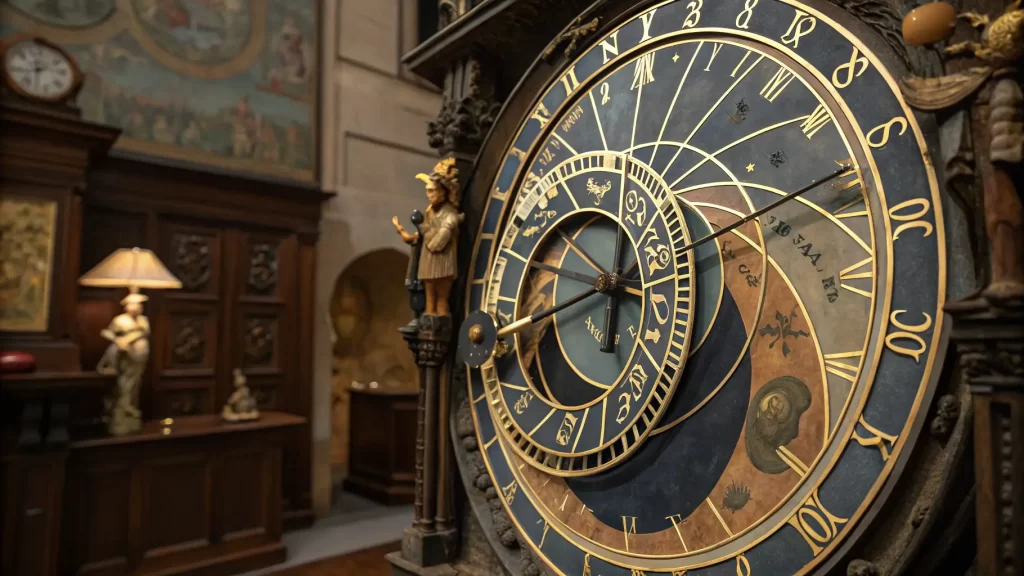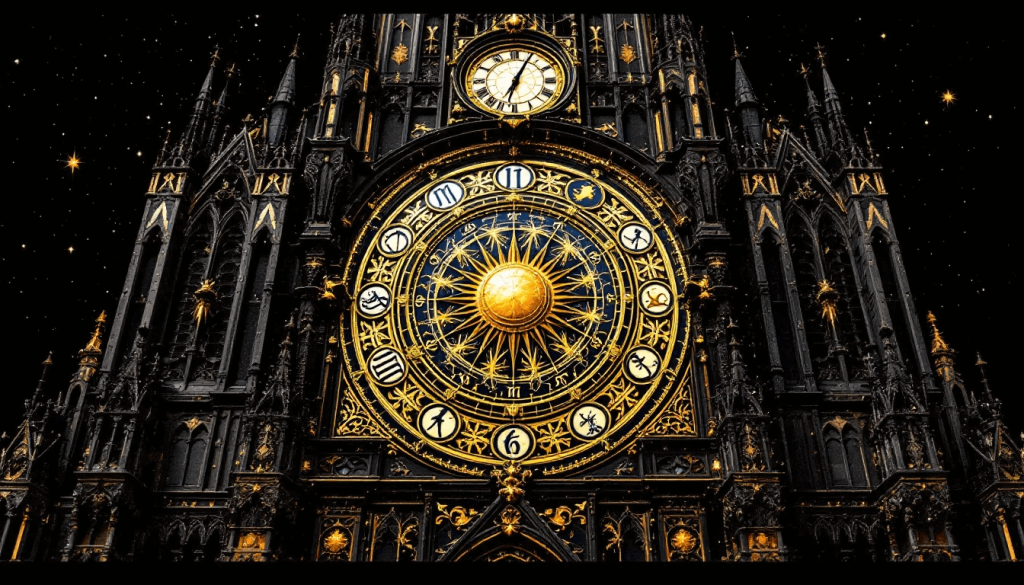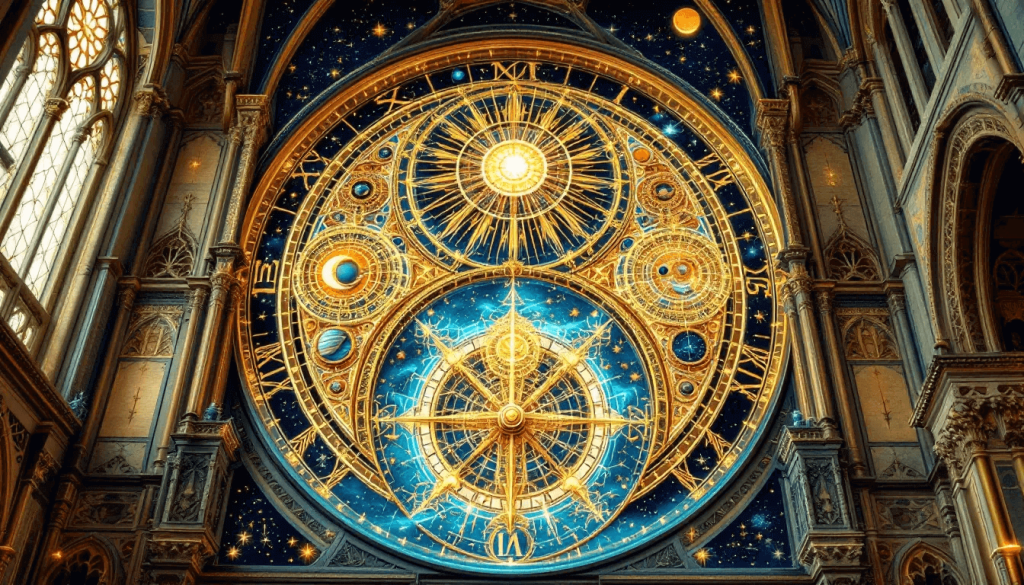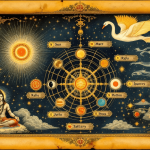7 Remarkable Astrological Clocks from Around the World
Aryan K | February 17, 2025

- Key Takeaways
- 1. The Prague Astronomical Clock
- 2. Su Song's Cosmic Engine
- 3. Wells Cathedral Clock
- 4. Al-Jazari's Castle Clock
- 5. The Rasmus Sørnes Clock
- 6. Jens Olsen's World Clock
- 7. Strasbourg Astronomical Clock
- Unique Features of Astrological Clocks
- Historical Significance and Restoration
- How Astrological Clocks Work?
- Where to See Astrological Clocks
- Modern Interpretations of Astrological Clocks
- Summary
- Frequently Asked Questions
An astrological clock is a marvel of engineering that not only tells time but also displays astronomical and astrological information. These clocks often feature intricate designs showing the positions of celestial bodies and zodiac signs, making them both functional devices and works of art. In this article, we will explore seven remarkable astrological clocks from around the world, each with its own unique history and features.
Key Takeaways
Astrological clocks, such as the Prague Astronomical Clock and Su Song’s Cosmic Engine, showcase advanced engineering, intricate designs, and significant cultural heritage, reflecting both historical astronomical knowledge and artistic expression.
Modern interpretations of astrological clocks merge traditional craftsmanship with contemporary technology, including features like digital displays and smartphone connectivity, appealing to a new generation of collectors and enthusiasts.
Restoration efforts are vital for preserving the historical and functional integrity of astrological clocks, ensuring that these remarkable timepieces continue to educate and inspire future generations.
1. The Prague Astronomical Clock

The Prague Astronomical Clock, known locally as the Orloj, is a masterpiece of medieval engineering and one of the oldest working astronomical clocks in the world. First installed in 1410, the Orloj stands proudly on the southern wall of the Old Town Hall in the heart of Prague, Czech Republic. This clock has witnessed centuries of history and continues to enchant visitors with its intricate design and mechanical ingenuity.
Before:
The Orloj features three main components: the astronomical dial, the calendar dial, and the Walk of the Apostles. The astronomical dial is a marvel in itself, showing the position of the Sun and Moon, the zodiacal ring, and various astronomical details. The calendar dial, added around 1490, displays the months and feast days, adorned with the signs of the zodiac. Every hour, on the hour, the clock comes to life with the Walk of the Apostles, a procession of twelve wooden figures of the Apostles that captivates onlookers.
After:
The Orloj features three main components:
The astronomical dial shows the position of the Sun and Moon, the zodiacal ring, and various astronomical details.
The calendar dial, added around 1490, displays the months and feast days, adorned with the signs of the zodiac.
The Walk of the Apostles, comes to life every hour on the hour with a procession of twelve wooden figures of the Apostles that captivates onlookers.
The clock’s design is not only a testament to the craftsmanship of its creators but also a reflection of the astronomical knowledge of the time. It showcases the geocentric model of the universe that was prevalent during the medieval period. The blue and gold face of the clock represents the Earth and the celestial sphere, with an outer ring marking the 24-hour cycle. The Orloj’s hour hand is adorned with a golden Sun that moves along the ecliptic, indicating the current time in both Old Czech Time and Central European Time.
Despite being over six centuries old, the Prague Astronomical Clock remains a symbol of the city’s rich history and cultural heritage. It has undergone several restorations, the most recent in 2018, to ensure its preservation for future generations. Today, it continues to draw crowds from around the world, standing as a testament to the ingenuity and artistic vision of its creators.
2. Su Song’s Cosmic Engine
In the ancient city of Kaifeng, during the Song Dynasty, Su Song’s Cosmic Engine emerged as a pioneering feat of hydromechanical engineering. Completed in 1094, this astronomical clock tower combined water power and clockwork mechanisms to create an unparalleled timekeeping device. Su Song, a polymath and engineer, designed the clock to regulate time using an innovative escapement mechanism, drawing inspiration from earlier Tang Dynasty designs.
Atop the clock tower stood a large, rotating armillary sphere that showcased the movements of celestial bodies, providing a visual representation of the heavens. This sphere, along with the clock’s endless power-transmitting chain drive known as the ‘celestial ladder,’ marked significant advancements in horological technology.
Su Song’s Cosmic Engine showcased the ingenuity of ancient Chinese engineering and laid the groundwork for future advancements in mechanical clocks and astronomical instruments.
3. Wells Cathedral Clock

The Wells Cathedral Clock, dating back to the 14th century, is a remarkable example of medieval horology. Situated in Somerset, England, this clock is one of the oldest working astronomical clocks still in operation today. Its historical significance lies not only in its age but also in its intricate design and the astronomical information it provides.
The clock features a geocentric design, depicting the Earth at the center with the Sun and Moon revolving around it. This design reflects the medieval understanding of the universe, where celestial bodies were thought to orbit the Earth. The clock face is adorned with vibrant colors and detailed illustrations, capturing the essence of medieval craftsmanship. Every quarter-hour, a jousting scene is played out by knights on the dial, adding a touch of whimsy to this historical artifact.
The Wells Cathedral Clock continues to function as a testament to the ingenuity of its creators and the rich history of horological advancements in medieval Europe. Its enduring operation and the meticulous care taken to preserve it make it a must-see for visitors to the cathedral. The clock serves as both a timekeeping device and a piece of living history, linking us to past scientific and artistic achievements.
4. Al-Jazari’s Castle Clock
Al-Jazari’s Castle Clock, built in 1206, stands as a testament to the advanced engineering and creativity of its time. This sophisticated water-powered astronomical clock reached an impressive height of 33 meters and incorporated various innovative features. Al-Jazari, a renowned Muslim polymath and engineer, designed the clock to not only tell time but also to display the movements of the celestial bodies with remarkable accuracy.
One of the most unique aspects of Al-Jazari’s Castle Clock was its detailed zodiac displays and musician automata. The zodiac signs were meticulously crafted, providing a visual representation of the astrological beliefs of the period. Additionally, the clock featured musician automata that played music when specific levers were activated, adding an element of entertainment to its functionality.
The Castle Clock’s height and intricate design exemplify the technological advancements of the Islamic Golden Age. Al-Jazari’s work laid the foundation for future developments in both horology and mechanical engineering, showcasing the rich scientific heritage of the Middle East.
5. The Rasmus Sørnes Clock
The Rasmus Sørnes Clock is a marvel of modern astronomical clockmaking, known for its complexity and precision. Created by Norwegian inventor Rasmus Sørnes, this clock is considered one of the most intricate astronomical clocks ever made. Sørnes dedicated his life to the creation of this masterpiece, crafting each component with meticulous care and attention to detail.
The clock features a plethora of astronomical functions, including the positions of the Sun and Moon, Julian and Gregorian calendars, sidereal time, GMT, daylight saving adjustments, leap years, and corrections for solar and lunar cycles. This extensive range of functionalities made the Rasmus Sørnes Clock a pinnacle of horological achievement, capable of providing accurate timekeeping and astronomical data.
Only four clocks of this type were ever made, each representing the culmination of Sørnes’ dedication and craftsmanship. The Rasmus Sørnes Clock stands as a testament to human ingenuity and the relentless pursuit of precision in the field of horology.
6. Jens Olsen’s World Clock
Located in Copenhagen City Hall, Jens Olsen’s World Clock is a masterpiece of mechanical engineering and astronomical precision. Completed in 1955 after over a decade of meticulous work, this clock is renowned for its complexity and capability to calculate planetary positions for the next 2,500 years. With 15,448 parts, Jens Olsen’s World Clock is one of the most intricate mechanical clocks in existence.
The clock features multiple dials and displays that illustrate various astronomical phenomena, including sidereal time, solar time, and lunar phases. Its most impressive feature is a mechanism that completes a rotation every 25,753 years, showcasing the clock’s incredible precision and the depth of Olsen’s astronomical knowledge. The clock not only serves as a functional timepiece but also as a scientific instrument of significant historical value.
Jens Olsen’s World Clock attracts visitors worldwide, symbolizing Denmark’s rich horological heritage and the achievements of its creator.
7. Strasbourg Astronomical Clock
The Strasbourg Astronomical Clock, located in the Notre Dame Cathedral, is a marvel of Renaissance engineering and art. The current clock, completed in 1843, is the third iteration in this location, designed by Jean-Baptiste Schwilgué. Schwilgué spent several years preparing a skilled team before embarking on the construction, ensuring the clock’s precision and artistic excellence.
The clock features an intricate astronomical dial that displays the positions of the Sun and Moon, the phases of the Moon, and various other celestial phenomena. Animated figures, including the Apostles and a rooster that crows at noon, add a dynamic element to the clock, drawing crowds of visitors every day. The Strasbourg Astronomical Clock is not only a timekeeping device but also a work of art that reflects the scientific and artistic achievements of its era.
The clock is a major attraction in Strasbourg today, captivating visitors with its intricate design and historical significance. It stands as a testament to the ingenuity of its creators and the enduring fascination with celestial mechanics.
Unique Features of Astrological Clocks

Astrological clocks blend art and science, making them more than mere timekeeping devices. The calendar dial, which often includes zodiac signs and saint feast days, indicates the current astrological sign based on the Sun’s position. This dial not only serves a practical purpose but also adds a layer of cultural and historical significance to the twelve zodiac signs clock.
Another fascinating feature is the moon phase indicator, which shows the current phase of the Moon as it waxes and wanes. This feature is crucial for those who rely on lunar cycle corrections for various activities, from agriculture to religious observances. Some clocks even include a ‘dragon’ hand that tracks the lunar nodes, which are essential for predicting eclipses.
Modern astrological clocks enhance traditional features with contemporary technology. Advanced sensors and smartphone connectivity allow for real-time astronomical data, making these clocks not only historical artifacts but also functional modern instruments. This blend of tradition and technology ensures that astrological clocks continue to capture the imagination of both enthusiasts and collectors.
Historical Significance and Restoration
Astrological clocks encapsulate the astronomical knowledge and artistic expression of their respective eras, holding profound historical significance. These timepieces are not merely functional devices but also cultural artifacts that offer insights into the scientific and artistic achievements of their time. The oldest operational astronomical clock, located in Prague, serves as a focal point in understanding the evolution of timekeeping and astronomy.
Restoration efforts are crucial for preserving these historical marvels. Over the years, many astrological clocks have been meticulously restored to their former glory. For instance, the Prague Astronomical Clock underwent significant restoration in 2018, revealing hidden aspects of its design and ensuring its continued operation. These efforts highlight the ongoing commitment to preserving the legacy of these remarkable timepieces.
The intricate craftsmanship and technological advances seen in astrological clocks reflect the rich historical context of their creators’ eras. By restoring and maintaining these clocks, we ensure that future generations can continue to marvel at their beauty and ingenuity, keeping the legacy of their creators alive.
How Astrological Clocks Work?
Astrological clocks blend astronomical knowledge with mechanical engineering in intricate designs. At the heart of these clocks is the astronomical dial, which resembles a mechanical clock astrolabe. This dial typically shows the position of the Sun, Moon, and zodiac constellations, providing a visual representation of the heavens.
The astronomical dial usually features a 24-hour analog display with local noon at the top, allowing for the indication of time throughout the day. Some clocks also include a ‘dragon’ hand, which tracks the lunar nodes and is essential for predicting eclipses. These advanced features illustrate both solar and lunar movements, offering a comprehensive view of celestial mechanics.
Astrological clocks are designed with various other functionalities, such as tracking sidereal time, Greenwich Mean Time (GMT), and providing adjustments for daylight saving time and leap years. Many of these clocks also include a perpetual calendar that calculates dates, and zodiacs, and displays moon phases. These intricate mechanisms showcase the advanced engineering and astronomical knowledge embedded in each timepiece.
Where to See Astrological Clocks
Astrological clocks can be admired in various locations around the world, not just confined to history books. These remarkable timepieces illustrate astronomical phenomena and serve as both functional devices and cultural artifacts. Many are housed in museums and city centers, drawing visitors from near and far.
Located in the Old Town Hall of Prague, the Prague Astronomical Clock is the oldest working astronomical clock with intricate designs and zodiac signs. Jens Olsen’s World Clock, found in Copenhagen City Hall, is renowned for its advanced mechanical features that display various astronomical phenomena. Both clocks are prime examples of the ingenuity and craftsmanship of their creators and are must-see attractions for any horology enthusiast.
Other notable astrological clocks include the Strasbourg Astronomical Clock, housed in Strasbourg Cathedral, which is famous for its detailed astronomical dial and animated figures. These clocks not only provide a glimpse into the past but also continue to captivate and inspire visitors with their intricate designs and historical significance.
Modern Interpretations of Astrological Clocks
The resurgence of interest in astrology has spurred a market for modern astrological clocks that appeal to both enthusiasts and collectors. These contemporary versions often blend traditional craftsmanship with modern technology, creating timepieces that are both functional and aesthetically pleasing.
Modern astrological clocks incorporate digital displays, sensors, and smartphone connectivity, providing real-time astronomical data and enhancing functionality. These clocks are designed to be interactive, allowing users to customize astrological readings based on personal data. This fusion of tradition and technology ensures that astrological clocks remain relevant and captivating in the modern world.
By combining the precision and artistry of traditional astrological clocks with the convenience and capabilities of modern technology, these contemporary interpretations continue to capture the imagination of a new generation of enthusiasts. Whether used as a decorative piece or a functional tool, modern astrological clocks offer a unique blend of history and innovation, making them a cherished addition to any collection.
Summary
Astrological clocks are more than just timekeeping devices; they are intricate works of art that encapsulate the astronomical knowledge and artistic expression of their respective eras. From the Prague Astronomical Clock to Jens Olsen’s World Clock, these timepieces offer a fascinating glimpse into the past and the minds of their creators. Their unique features, such as calendar dials, moon phase indicators, and zodiac displays, highlight the blend of art and science that defines these remarkable clocks.
Restoration efforts have played a crucial role in preserving these historical marvels, ensuring that future generations can continue to admire their beauty and ingenuity. The meticulous care taken to restore and maintain these clocks reflects the ongoing commitment to preserving our cultural heritage and the legacy of their creators.
Modern interpretations of astrological clocks have brought these timepieces into the 21st century, blending traditional craftsmanship with contemporary technology. By incorporating advanced features and interactive elements, these modern versions continue to captivate and inspire enthusiasts and collectors alike. The enduring fascination with astrological clocks is a testament to their timeless appeal and the human desire to understand and connect with the cosmos.
Frequently Asked Questions
What is the oldest working astronomical clock in the world?
The oldest working astronomical clock in the world is the Prague Astronomical Clock, known as the Orloj, which has been in operation since its installation in 1410. It remains a significant historical and functional timepiece to this day.
What are some unique features of astrological clocks?
Astrological clocks uniquely incorporate calendar dials marked with zodiac signs, moon phase indicators, and sophisticated mechanisms that track sidereal time and lunar nodes, enhancing their functionality for predicting celestial events like eclipses.
Where can I see Jens Olsen’s World Clock?
Jens Olsen’s World Clock is located in Copenhagen City Hall, Denmark, and is renowned for its complex mechanical design and astronomical calculations.
How do modern astrological clocks differ from historical ones?
Modern astrological clocks significantly differ from historical ones by integrating digital displays, advanced sensors, and smartphone connectivity, allowing for real-time astronomical data and interactive features. This fusion of traditional craftsmanship with contemporary technology enhances user experience and accessibility.
What restoration efforts have been made to preserve astrological clocks?
Restoration efforts for astrological clocks, such as the significant 2018 overhaul of the Prague Astronomical Clock, aim to preserve their functionality and historical significance. These efforts not only ensure operational integrity but also uncover previously hidden design features.
Recent Posts

What Is Mahadasha? How It Affects Your Life & Destiny
Aryan K | February 21, 2025

Traits of Aries Born on April 11: What Makes You Unique?
Aryan K | February 21, 2025

Understanding the June 11 Zodiac Sign: Gemini Traits and Compatibility
Aryan K | February 21, 2025

Discover the Best Astrologers in Canada for Insight and Guidance
Olivia Marie Rose | February 21, 2025

Transcendental Meditation: What It Is, Benefits, and How to Get Started
Olivia Marie Rose | February 20, 2025
Topics
- Angel Numbers
- Astrology and Birth Charts
- Baby Names
- Best Astrologers
- Business
- Career
- Celebrities and Famous Personalities Astrological Profile
- Children
- Chinese Astrology
- Festivals
- Finance
- Gemstones
- Kundli
- Love
- Marriage Prediction
- Nakshatra
- Numerology
- Pets
- Rudraksha
- Spirit Animals
- Spirituality and Positivity
- Symbolism
- Tarot
- Understanding Hinduism
- Vastu
- Vedic
- Western Astrology Charts
- Yoga and Meditation
- Zodiac Sign Date Calendar
- Zodiac Signs
